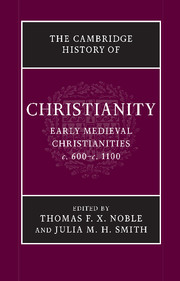Book contents
- Frontmatter
- Introduction: Christendom, c. 600
- Part I Foundations: Peoples, Places, and Traditions
- Part II Christianity in Confrontation
- Part III Christianity in the Social and Political Order
- Part IV Christianity as Lived Experience
- Part V Christianity: Books and Ideas
- 24 Visions of God
- 25 Orthodoxy and deviance
- 26 Making sense of the Bible
- 27 The Christian book in medieval Byzantium
- 28 Saints and their cults
- 29 Last Things
- Conclusion: Christendom, c. 1100
- Bibliographies
- Index
- References
28 - Saints and their cults
from Part V - Christianity: Books and Ideas
Published online by Cambridge University Press: 28 March 2010
- Frontmatter
- Introduction: Christendom, c. 600
- Part I Foundations: Peoples, Places, and Traditions
- Part II Christianity in Confrontation
- Part III Christianity in the Social and Political Order
- Part IV Christianity as Lived Experience
- Part V Christianity: Books and Ideas
- 24 Visions of God
- 25 Orthodoxy and deviance
- 26 Making sense of the Bible
- 27 The Christian book in medieval Byzantium
- 28 Saints and their cults
- 29 Last Things
- Conclusion: Christendom, c. 1100
- Bibliographies
- Index
- References
Summary
In 628, the Persians executed a Christian monk at Kirkuk. The death of Anastasius was a minor episode in decades of conflict between the Byzantine and Sasanian empires, but his was no ordinary fate. A Persian soldier who converted from Zoroastrianism to Christianity and become a monk near Jerusalem, Anastasius had strengthened his new identity by contemplating wall-paintings of early Christian martyrs, and then set out to seek death at the hands of his former comrades. Three years after his decapitation, his fellow monks managed to retrieve his head, and as they carried it back to their Palestinian monastery, it started working miracles. Anastasius had become a potent symbol of Christian triumph in desperate times, and when his monastic community fled to Rome after the fall of Jerusalem to the Arabs in 638, they took his head with them. There, accounts of his martyrdom and miracles were soon rendered from Greek into Latin. Taken to England in the later seventh century, the stories of Anastasius took new form in Old English by the late ninth century, in testimony to his popularity throughout early medieval Christendom.
“My heart trembles and my insides are loosened whenever I remember [the] miracles which our Lord Jesus Christ accomplished through his blessed martyr Anastasius,” announced the cleric who recorded a dramatic event which had occurred in Rome in 713. It concerned a young woman confined to a nunnery, whom the devil was believed to have possessed at the instigation of a jilted suitor. Her father, Theopentus, a Syrian bishop from Osrhoene, had turned for help to the renowned saint from his eastern homeland and had taken his daughter into a church on whose altar the martyr’s head lay. One of his teeth was hung around her neck but failed to dislodge the demon, and for a month she flailed around with the devil inside her yelling abuse at Christ, his saints, and the Christian clergy.
- Type
- Chapter
- Information
- The Cambridge History of Christianity , pp. 581 - 605Publisher: Cambridge University PressPrint publication year: 2008
References
- 2
- Cited by



